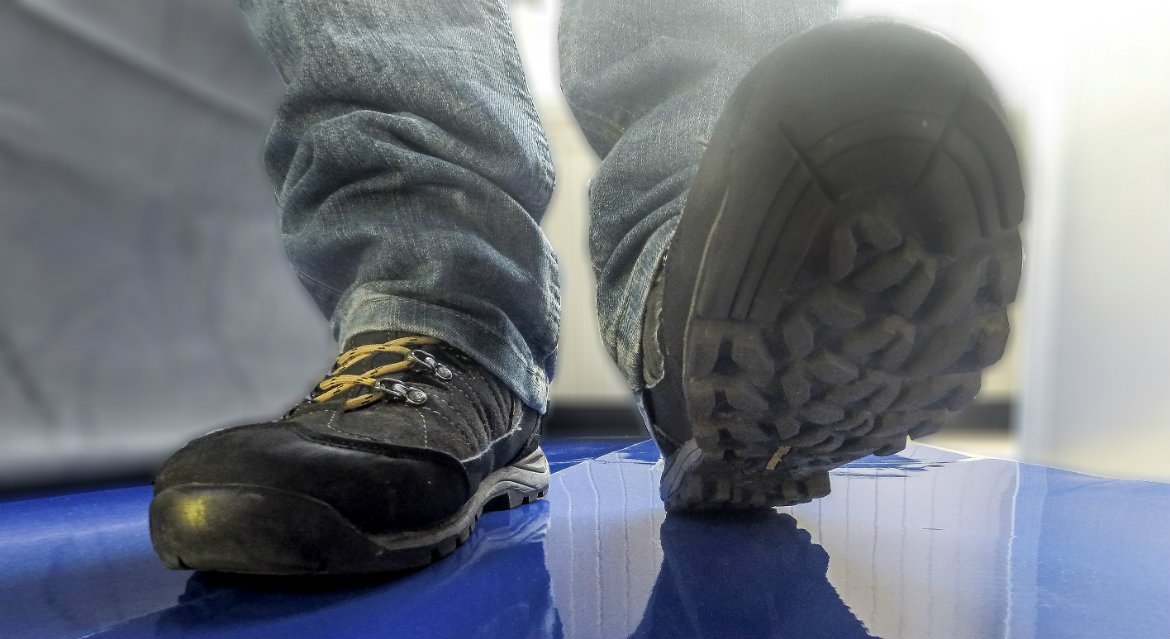Public ‘Sole Searching’ to help forensic science research
Published On Wed 13 Mar 2019 by Grant Hill

Image is credit G.S. Thomson 2018
Members of the public are being invited to do some ‘sole searching’ and get involved in a University of Dundee project aiming to help forensic science take a step forward in creating a new research database.
Footwear marks, also called shoeprints, deposited at crime scenes may be used to link a type of shoe or possibly even a specific shoe to the scene. Being able to do this in a way that is scientifically valid requires information about how a mark that a shoe makes changes over time or changes when it is made on different surfaces or with different pressures and activities, such as jumping, running and walking.
The University’s Leverhulme Research Centre for Forensic Science (LRCFS) is undertaking the largest ever study into the variation in footwear marks made by the same shoes across different surfaces and activities so that the variation observed can be used to explore links between the shoe and the mark it makes.
In order to do this, they are asking thousands of individuals to take part in a large-scale citizen science project by taking pictures of their footwear and the marks they make. This will help the Dundee team build a substantial database for use in their research to aid the scientific validation of footwear marks as evidence for use in the criminal justice system.
Professor Niamh Nic Daeid, Director of LRCFS, said, “Footwear marks are a common evidence type found at crime scenes and can be made on many different surfaces. They are recovered by crime scene examiners and may be used to potentially determine the footwear type and possibly other information to try and identify a specific shoe or to link crime scenes together. However we have little scientific studies to help us in understanding how certain we can be about such links.
“Within our research centre we want to explore new ideas and approaches for tackling some of the challenges in forensic science, particularly around creating open databases of information that forensic scientists need. One way we are doing this is through Citizen Science projects, giving people the opportunity to contribute to real research and to generate new data and knowledge.
“Sole Searching is the first of these citizen science projects, all of which will emphasise the importance of good data collection and careful recording of results – both are a fundamental part of conducting good science.
“The critical part of the work we are undertaking is that we build in repetition into our tests so that we can understand the variation that there will be in the footwear marks obtained when multiple marks are made by the same people with the same shoes and under the same conditions.”
Schoolchildren in and around Dundee are among those who will be participating in the Sole Searching project. The experiment is an ideal classroom activity and appears in the secondary schools activity pack produced by the British Science Association for British Science Week.
The images and measurements that participants provide will demonstrate the marks that different types of footwear make when the wearer is standing, walking, running and jumping. The researchers will also find out more about how characteristics such as cuts or worn soles appear (or not) in multiple footwear marks made by the same shoe and person.
In 2009, a report by the National Academy of Sciences (NAS) in the United States challenged the scientific credibility of a wide range of forensic evidence types including those which relied on direct physical comparative processes, such as footwear mark comparison. Ten years after that report emerged little has changed and the LRCFS team aim to rectify this in part by empowering citizens to help them gather relevant data.
The Leverhulme Research Centre in Forensic Science is a 10-year, £10million project funded by the Leverhulme Trust and directed by Professor Nic Daeid. Working closely with both Scottish and English judiciaries, forensic scientists and law enforcement, LRCFS’ aim is to improve public and judicial confidence in forensic science. The team is making continuous progress in addressing the issues identified in the 2009 NAS report.
To get involved in the Sole Searching project please visit https://www.dundee.ac.uk/leverhulme/citizenscience/details/sole-searching.php.
A video taking people through the experiment can be found at and participants can let others know about the experiment using the #forensicshoeprints hashtag on social media.
For media enquiries contact:
Grant Hill
Press Officer
University of Dundee
Nethergate, Dundee, DD1 4HN
Tel: +44 (0)1382 384768
Mobile: 07854 953277
Email: g.hill@dundee.ac.uk